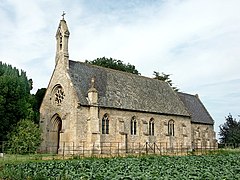Brothertoft
| Brothertoft | |
|---|---|
 St Gilbert of Sempringham, Brothertoft |
|
| Brothertoft shown within Lincolnshire | |
| OS grid reference | TF272461 |
| • London | 105 mi (169 km) S |
| Civil parish | |
| District | |
| Shire county | |
| Region | |
| Country | England |
| Sovereign state | United Kingdom |
| Post town | BOSTON |
| Postcode district | PE20 |
| Dialling code | 01205 |
| Police | Lincolnshire |
| Fire | Lincolnshire |
| Ambulance | East Midlands |
| EU Parliament | East Midlands |
| UK Parliament | |
Brothertoft is a village in Lincolnshire, England, about 4 miles (6.4 km) north-west from the market town of Boston. It is part of the civil parish of Holland Fen with Brothertoft .
Evidence has been found that the area now known as Brothertoft was known to the Romano-British people. The site of a possible building was uncovered at Cannons Farm in Punchbowl Lane between 1957 and 1959. A denarius of Septimius Severus was found along with pottery, potsherds, animal bones, ditches and hollows. A Roman vase was dug up about 1970 at a separate site in Brothertoft by Mr Epton.
The hamlet is first recorded some time after 1350 and before 1540. Brothertoft hamlet is mentioned in the Diocesan Return of 1563 (Deanery of Holland, parish of Kirton,) as having ten households.William Marrat, a local historian writing in 1814, noted that the traditional belief for the origins of the village name lay in a grant being awarded to two brothers in order that they could "inclose" (that is, separate and cultivate) the area from the surrounding fenland. The word toft is thought to come from the Danish occupiers of Lincolnshire in ancient times and has the meaning of homestead or enclosure. Hence the place name of Brother-Toft. In an addendum Marrat wrote that the place had been a vaccaria (or vaccary - literally, a cow shed) of the abbey at Swineshead and had once been called Toft because of it relatively raised position above the fens. There are records of receipts which were probably from the area in the Swineshead entries of the Valor Ecclesiasticus. These are not definitive as another historian of the period, Pishey Thompson, pointed out that Toft was used as a name both for Brothertoft and Fishtoft in the late fourteenth century. The raised position did not exclude the area from flooding and, for example, in 1763 the villagers were forced to live in the upper stories of buildings due to the amount of water ingress.
...
Wikipedia

